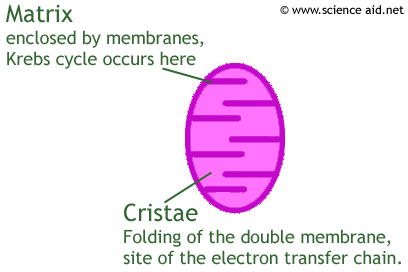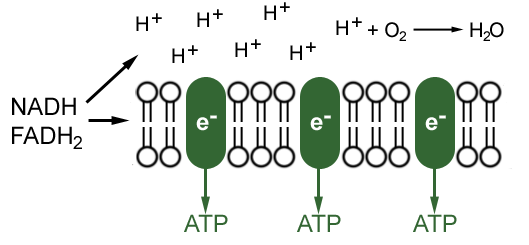Respiration
Mitochondrion
Before we look at respiration, it is useful to study where respiration happens. Below is an annoted diagram of a mitochondrion: the mitochondria are important organelles in all cells.

Glycolysis
Glycolysis is a series of reactions that take place in the cell cytoplasm. It involves the oxidation of glucose in to pyruvate (a 3 carbon compund), and produces (overall) ATP and reduced NAD: an enzyme which is carrying hydrogen. The number of carbons in each of these compounds is indicated in the green circle.

Now, the product: pyruvate (or pyruvic acid) is actively transported in to the mitochondria where the link reaction occurs. Here, the pyruvate molecule combines with coenzyme A to form the 2 carbon acetylcoenzyme A. Producing carbon dioxide and hydrogen.

Krebs Cycle
Like the link reaction, the Krebs Cycle occurs in the matrix of the mitochondrion. The reaction is as follows:

The acetyl CoA from the link reaction combines with Oxaloacetic acid to form citric acid, this is then broken down to produce some ATP and reduced NAD and FAD (NADH and FADH).
The many hydrogen molecules carried by NAD and FAD are also used to produce ATP, by being taken to a further stage...
Electron Transfer Chain
This process takes place on the inner mitochondrial membrane which is folded to cristae, this provides a large surface area for the electron transfer chain to take place.

The carriers FAD and NAD bring the hydrogen and it seperates to H+ and electrons (e-). The electrons pass from carrier to carrier and loose energy. This is used to synthesize ATP.
However, there are alot of hydrogen ions, unless removed, these would cause a large increase in pH, therefore, oxygen reacts with the ions to remove it and produce water. This is what the oxygen you breathe in is used for (in terms of respiration).
Updated: 16 May 2011.
